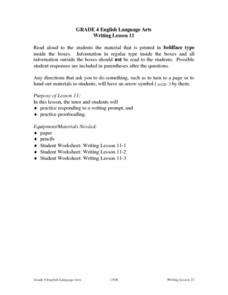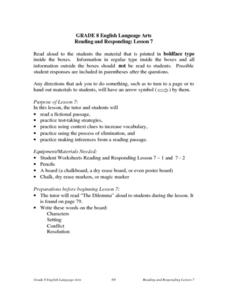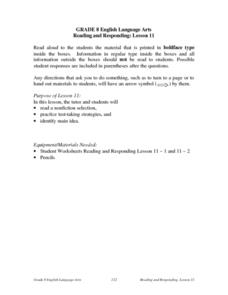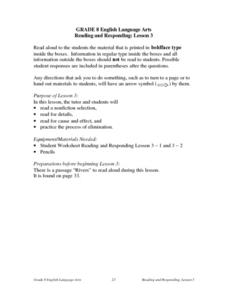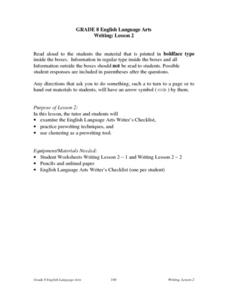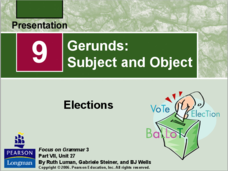Curated OER
Using a Writing Prompt
Fourth graders explore the writing process. They practice responding to a writing prompt. Students practice their proofreading skills and proofread their writing. They include a beginning, middle, and ending in their writing.
Curated OER
Using Information Resources: Lesson 4
Fourth graders review a variety of information resources and identify parts of a book. They practice brainstorming and practice skimming. They review all the research resources that are found in the library.
Curated OER
Reading and Responding -- Lesson 7
Fourth graders work individually or in a small group to (1) read a nonfictional selection, (2) identify main idea and details, (3) identify the author's purpose, and (4) practice test-taking strategies.
Curated OER
Reading and Responding: Lesson 24
Fourth graders explore fictional literature. They read a fictional passage and practice answering multiple choice questions about the text they read. Students complete short answer questions.
Curated OER
Responding to a Writing Prompt
Fourth graders explore the writing and proofreading process. They practice responding to a writing prompt. Students write three paragraphs about the given prompt and proofread their work.
Curated OER
Writing Lesson 9
Fourth graders explore the writing process by responding to a writing prompt. They practice responding to a given writing prompt. Students write about a daydream. They write two or three paragraphs about the topic.
Curated OER
Problem-Solving Strategy: Write an Equation
In this problem solving strategy worksheet, students practice writing equations as they respond to 4 questions that enable them to solve 2 word problems.
Curated OER
Reading and Responding -- Lesson 11
Fourth graders work independently or in a small group to (1) read a fictional selection, and (2) practice test-taking strategies. Reading passage, comprehension questions, and teacher script is included.
Curated OER
Reading and Responding: Lesson 3
Eighth graders practice reading a nonfiction selection. They read for details, read for cause and effect, and practice the process of elimination. They use these strategies when answering multiple choice questions in tests.
Curated OER
Inferences/Opinions
Fourth graders practice making inferences and forming opinions. In this reading strategy lesson, 4th graders listen to the book Woodsong by Gary Pauisen. They make predictions about the story before beginning and discuss the story...
Curated OER
Writing: Lesson 2
Eighth graders examine the English Language Arts Writer's Checklist. They practice prewriting techniques. Students use clustering as a prewriting tool. They discuss how a checklist is a lot like a map in that it guides you through the...
Curated OER
Decision: Reasonable Answers
For this problem solving worksheet, students solve a story problem about how many pennies each of 3 children has saved. Students identify answer choices that do not make sense. Students answer 5 questions that help solve the problem.
Curated OER
Number and Number Relations: Lesson 2
Fourth graders participate in using the terminology of more, less, between, compare, and order. They compare whole numbers and use the symbols for <, >, =. They order whole numbers and practice with problems where they use this...
Curated OER
Number and Number Relations: Lesson 3
Eighth graders compare whole numbers and decimals. They use symbols for <, >, =, and order whole numbers and decimals. They practice the meaning of positive and nugative integers by using them to describe real-world situations.
Curated OER
Geometry: Lesson 10
Eighth graders investigate the Pythagorean theorem and how it is used in geometry. Measurements for different triangles is given and then students must solve problems in order to practice using the formula.
Curated OER
The Nature and Science of Technology
Fifth graders practice using the scientific method by observing and creating mold. In this bacteria instructional activity, 5th graders experiment creating their own mold and fungus using petri dishes and oatmeal. Students...
Lisa Staab Shadburn
Play Therapy Activities to Enhance Self‐Esteem
Discover activities to help learners increase self-awareness, build peer and family relations, and develop positive self-esteem. Here you'll find six suggestions for instilling a sense of confidence and self awareness in youngsters. Each...
Mathematics Vision Project
Module 6: Trigonometric Functions
Create trigonometric functions from circles. The first lesson of the module begins by finding coordinates along a circular path created by a Ferris Wheel. As the lessons progress, pupils graph trigonometric functions and relate them to...
Compton Unified School District
How Can We Locate Places?
How can we locate places? Maps, of course! Expose second graders to the tools available in maps and discuss how these tools can help people find locations. Students also look at communities, including what makes a community and the...
EngageNY
Simplifying Square Roots
Explore the process of simplifying square roots through an analysis of perfect squares. The fourth instructional activity of 25 expects individuals to find the perfect square factors in each radicand as a means of simplifying. The...
Mathematics Vision Project
Module 3: Polynomial Functions
An informative module highlights eight polynomial concepts. Learners work with polynomial functions, expressions, and equations through graphing, simplifying, and solving.
Pearson
Gerunds: Subject and Object
Ace the next grammar quiz with the help of a presentation about subject and object gerunds! After defining the concept, the slides guide class members through different examples and activities with gerunds.
Cornell University
Constructing and Visualizing Topographic Profiles
Militaries throughout history have used topography information to plan strategies, yet many pupils today don't understand it. Scholars use Legos and a contour gauge to understand how to construct and visualize topographic profiles. This...
Read Works
Trading Pumpkins
Can you imagine a pumpkin patch without pumpkins? Learners read how Tammy's family solves their problem in a cooperative way, followed by a set of 10 reading comprehension questions.
